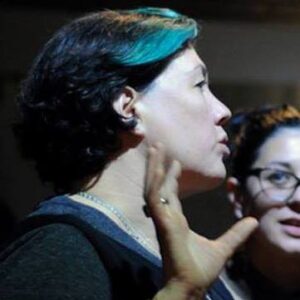 With the explosion of globalization and cutting-edge communication tools, a digital tribalism phenomenon has emerged of artists uniting into groups not on the grounds of geography, but according to interests.
With the explosion of globalization and cutting-edge communication tools, a digital tribalism phenomenon has emerged of artists uniting into groups not on the grounds of geography, but according to interests.
The exhibition, “Patterns of the Mind” showcases works by artists from different places in terms of geography, excited by similar themes that get embodied in various techniques and genres that use technologies as an artistic material. “Patterns of the Mind”, also exposes constants in a developing technological society – that no matter how fast the innovations develop, people are still creatures of habit, and what we love the most are the things that we understand and are used to.
Embodying this is the exhibited video, “Just My Own” by Alena Tereshko which asserts that in our post-postmodern age communication has significance – by no means unimportant, but only up to a point – to serve as a conduit for the message. From this piece and other included artworks, the “Patterns of the Mind” emerges: the message communicated reigns supreme and art is a tool for its transmission.
The message of a dream is represented in the installation, “Dream and Ball”, by Peter Belyi as well as in the musical performance “Sabih’s Dream” by Svjetlana Bukvich-Nichols. With regard to dreams, Belyi’s work reflects Descartes’ notion that in our night fantasies, we reason and express judgments in the same strict sense as in our waking state. Conversely, Bukvich-Nichols depicts an illusory, sensuous performance – a night fantasy, as Aristotle would say.
DRAMA (Greek δρᾶμα – action), in its ancient connotation of the word, becomes the form exemplified by artists Alexandra Dementieva and Marianna Ellenberg. In Dementieva’s “Drama House”, viewers press doorbells to call characters to appear in windows of a virtual house. The more intense the audience’s engagement, the more dramatic the projected situation becomes. Ellenberg’s “Ariella Von – S8mm” represents “DRAMA” from inside out: the viewpoint of a post-riot girl. Joggling video sketches, Ellenberg pulls spectator into her game where feelings and emotions define the real and virtual worlds.
DRAMA receives a different interpretation in the work of Peter Patchen. Patchen’s “The Request Close Touch” captures the moments building into a happening among that with a peaceful nature. A field of wheat obeys movement of a hand as it would an approaching thunderstorm. Wind gusts stir up the crop. One recognizes the signals to rush to shelter before the storm. Yet… We linger and pre-plan post the anticipated climax.
The mundane nature of desire unites the interactive installation “Voluptuousness” by artist duo Elena Gubanova and Ivan Govorkov. Human sexuality is personified, played with, and pondered in the video art of Carla Gannis’ “Shrimp Mermaid Goddess”. Embracing ironic wit, Gubanova-Govorkov present a gigantic fly trap that vibrates and hums to attract viewers. Gannis blurs lines between retro porn graphics and modern animated gif stylings; anonymous avatar spectator and tangible active individual; virtual technology connections and tangible relationships; coming to a climax and banality on repeat.
Contemplation into the meaning of life can be traced in works by Bryan Zanisnik and Alexander Terebenin. In “Modality”, Zanisnik questions the problem of time by uniting two fundamental concepts in his video – the absolute and the measurable. Taking a different approach, Terebenin chooses a detached position. In Terebenin’s “The Last Portrait”, ovals left from portraits fallen off gravestones are in process of endlessly aging, becoming an abstract but tangible view of eternity.
Works by Vitaly Pushnitsky are burned into handmade paper much like a shroud or images in an artist’s memory. The deeper the scorch – the darker and thinner the layer of heavy handmade paper is. In some spots, the paper turns into lace, in others – it disappears altogether, transforming a graphic image into a sculptural one.
The pieces, “ASCII Drawings” by Justin Berry and “Coup d’Oeil” by Pavel Ivanov, are related in the poetics of creative process. Each artist focuses on revealing their subjective grip of fleeting moments which comprises existence in a physical reality that itself holds bigger truths. Joseph Brodsky accurately summarizes the paradoxical relationship by writing, “The rain, being continuous, is something like self-actualization. Conversely, the train for which you, clad in a raincoat, are not waiting on the platform arrives on schedule”.
Text by: Anna Frants
Translator: Irina Barskova
Editors: Irina Barskova and Leah Shtuhltrager